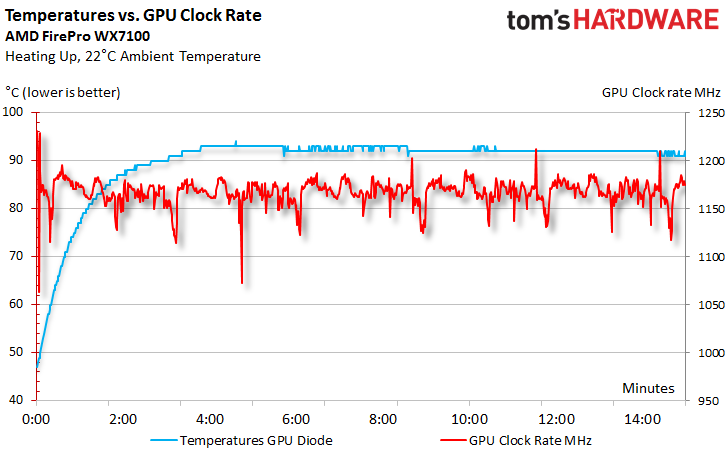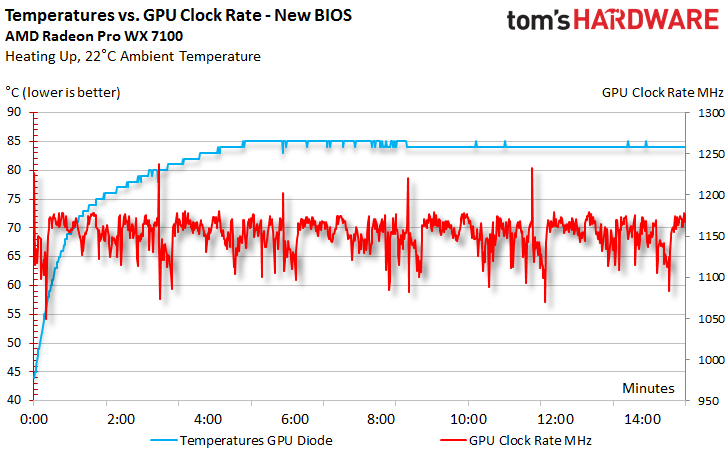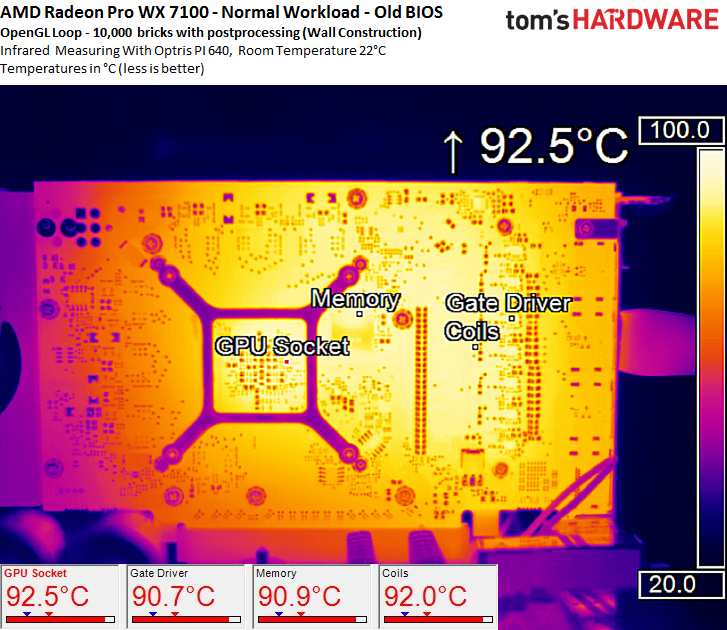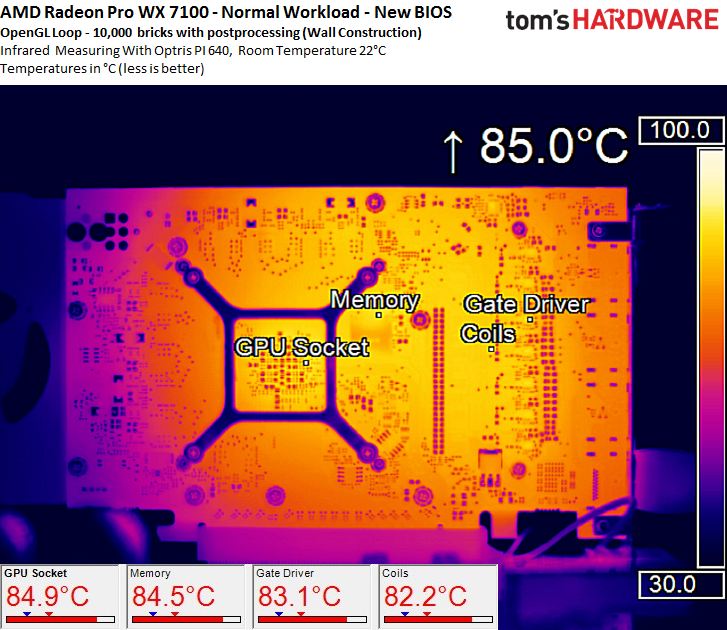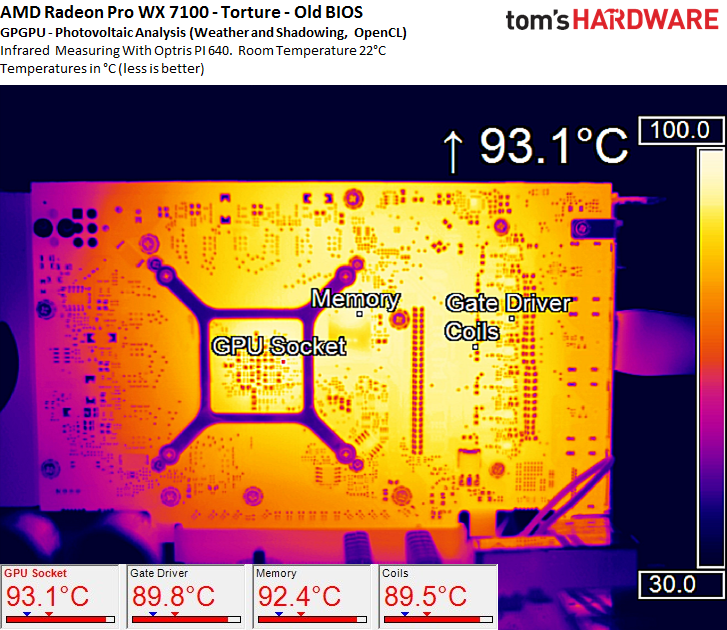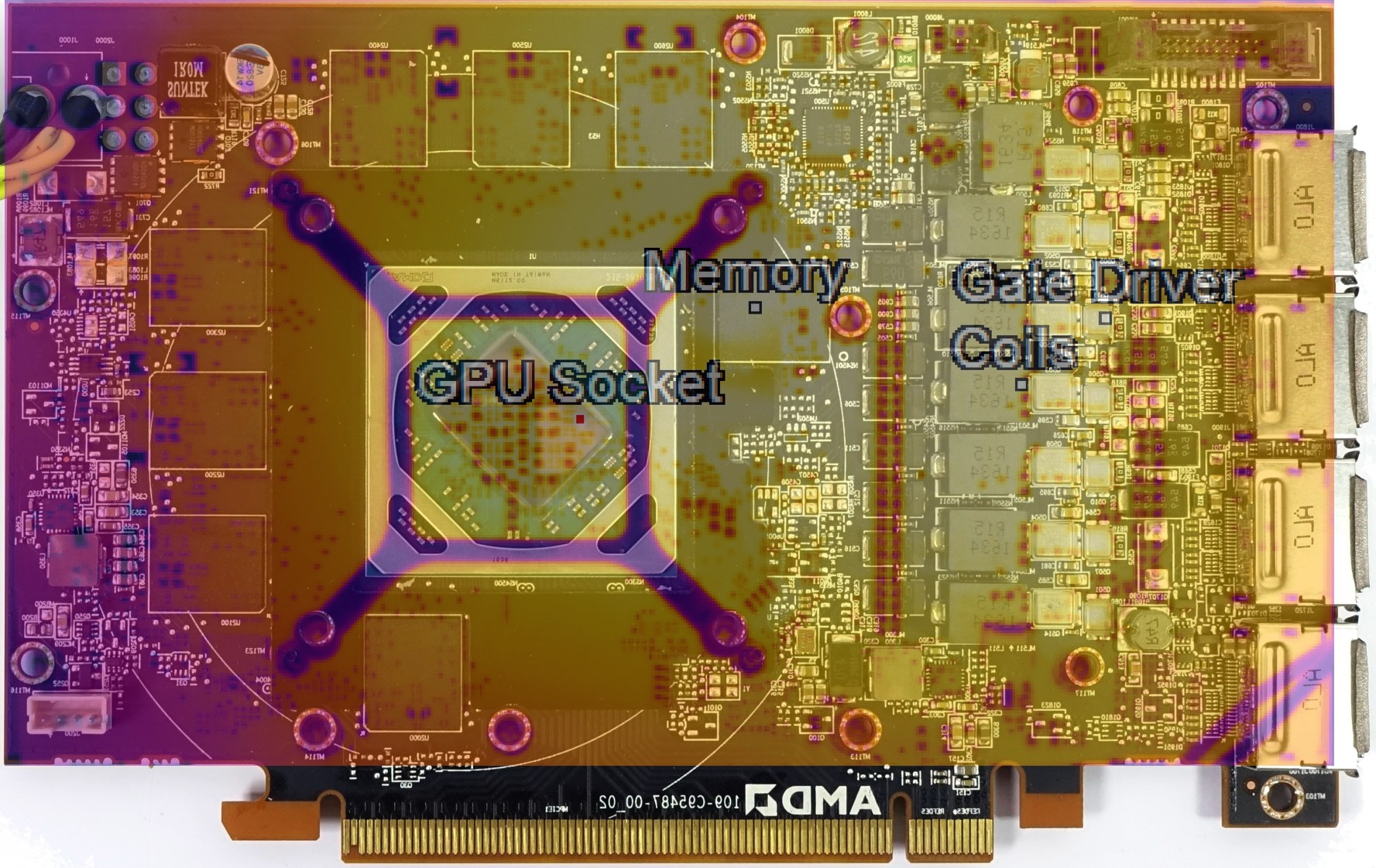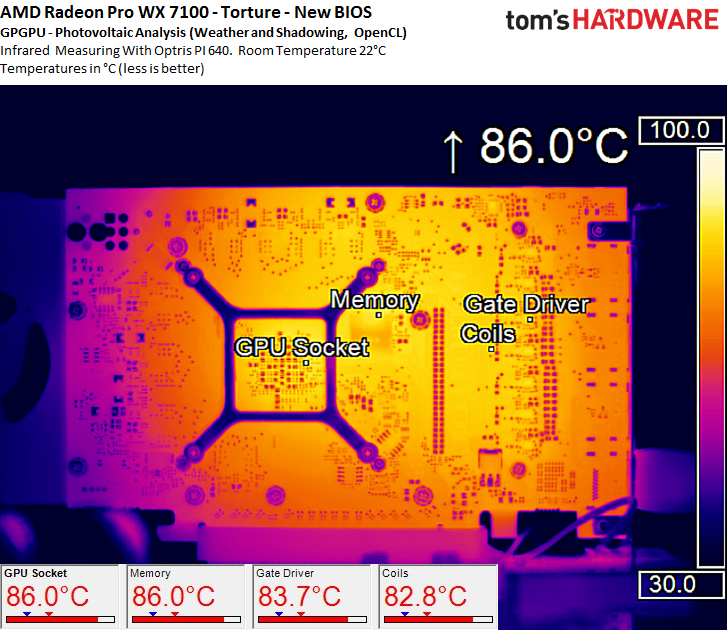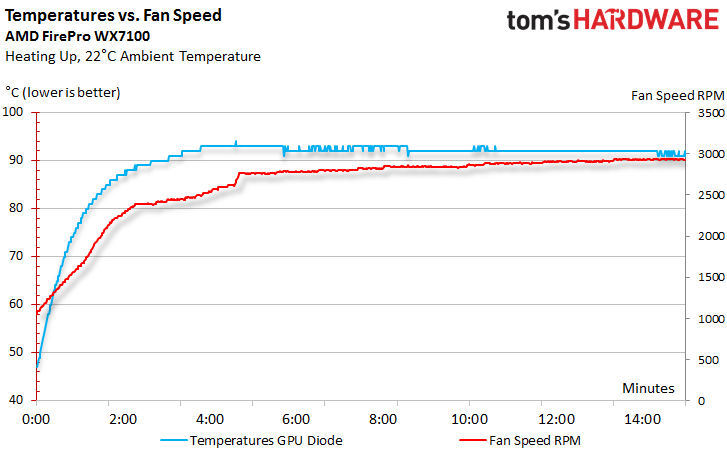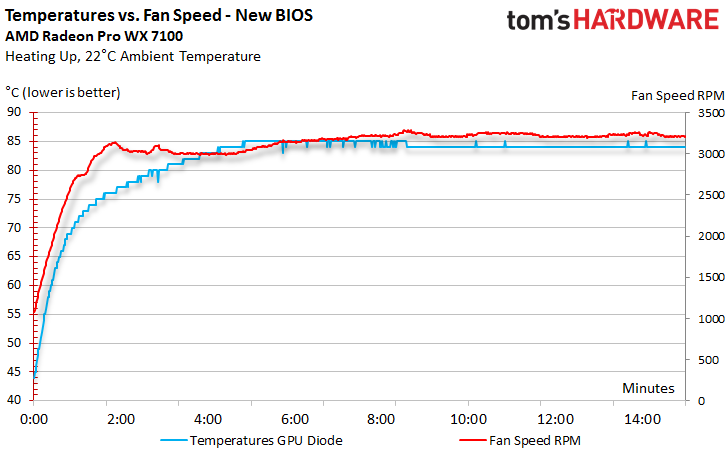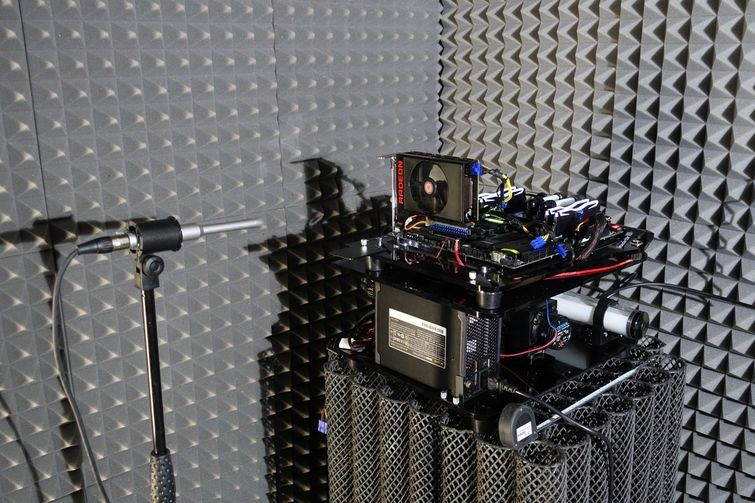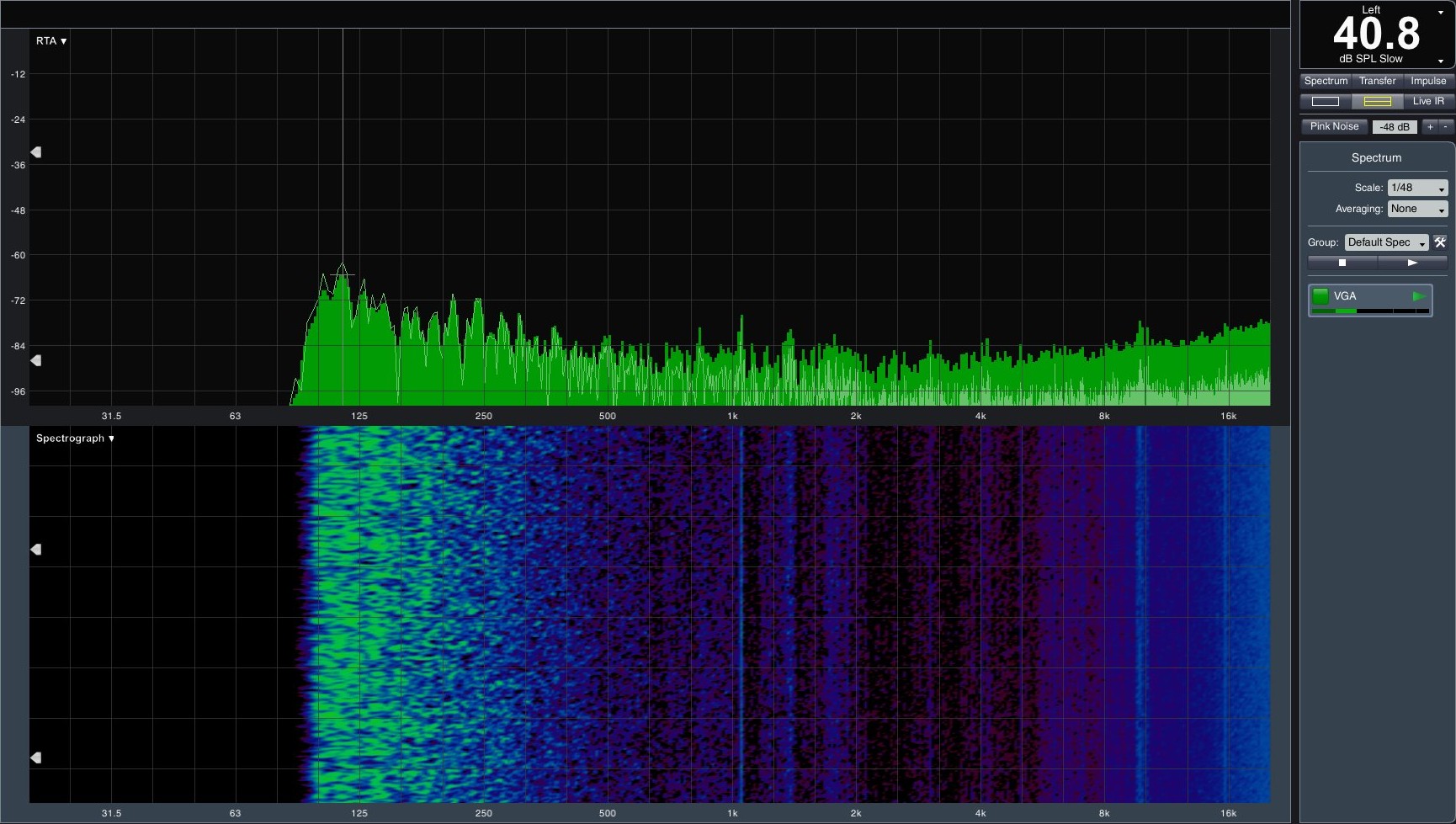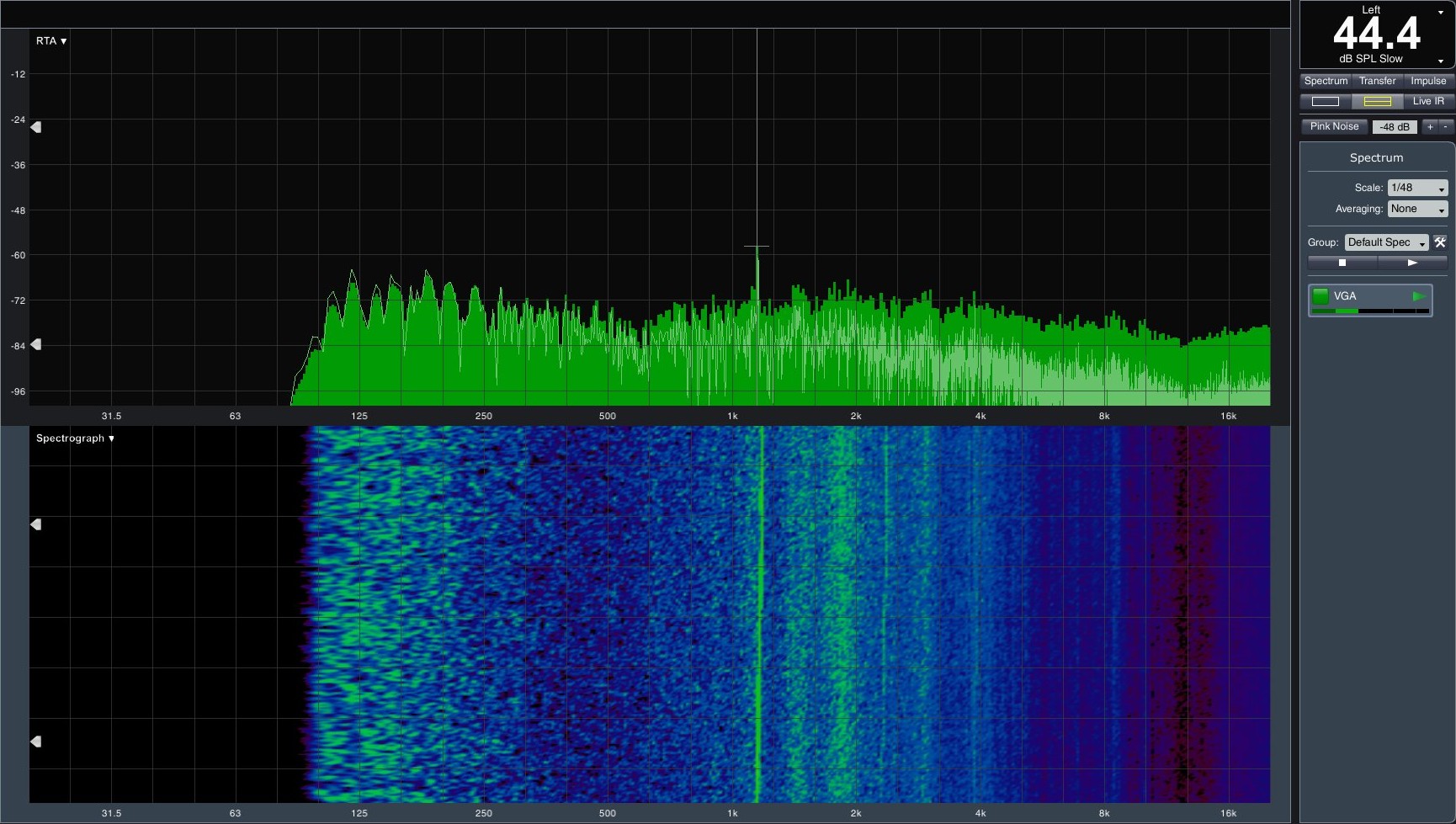AMD Radeon Pro WX 7100 Review
The FirePro brand is dead; long live the Radeon Pro. AMD puts its Polaris chips and reworked drivers to work in three new workstation graphics cards. We’re about to give the fastest model, the Radeon Pro WX 7100, a real workout.
Clock Rates, Temperature & Noise
Temperature & Clock Rates
Our first test charts the GPU's thermal performance through an OpenGL-based brick-building loop, while also monitoring clock rate. Incidentally, frequency hardly decreases over time, even when the GPU's diode crests the 90° mark. AMD set the old BIOS' temperature limit to 95°C. We think that's a bit too high for a professional graphics card.
Fortunately, the card operates closer to the GPU's sweet spot than AMD's higher-clocked Radeon RX 480, which uses a lot more power and can't maintain its initial clock rate. The Radeon Pro WX 7100 is generally more conservative, enabling its single-slot cooling solution.
Old BIOS
The temperatures are significantly higher than 90°C due to an inadequate fan curve. This isn't good for long-term durability.
New BIOS
Now the temperature is 85°C, eight degrees lower than what we measured with the old BIOS. That's a significant improvement.
Infrared Measurements: Old vs. New BIOS
But is the ideal of single-slot cooling really as admirable as it's believed to be?
The two test scenarios push a demanding load. The OpenGL-based wall-building benchmark matches our Metro Last Light gaming workload almost to the watt. Both tasks seem almost overwhelming to the old BIOS; the VRMs especially generate considerable heat.
There are two reasons for this. First, the top of the small VRM cooler receives too-little airflow as a result of diminished pressure. Second, the HEXFETs with metal housings create a lot of waste heat that ends up in the PCB and not the heat sink.
Get Tom's Hardware's best news and in-depth reviews, straight to your inbox.
The new BIOS counters that first problem with more air pressure, enabled by a higher fan speed.
This region is particularly impacted by the stress test, even though average power consumption does not rise. The voltage changes are moderate, after all, and the MOSFETs' efficiency curve clearly shifts in the wrong direction. Here's a look at the old BIOS:
Unfortunately, the issue related to the HEXFETs also relates to AMD's approach to component layout. Superimposing the front and back of the board shows that the gate drivers are located directly under the high-side MOSFET. Its waste heat causes a hot spot under the gate driver.
The new BIOS and drivers together offer a vastly improved infrared image.
Fan Speeds and Noise Output
Of course, higher fan speeds usually affect acoustics negatively. It appears AMD wanted to keep noise tightly under control with an original rotational speed of less than 3000 RPM. That led to the elevated temperatures documented in our infrared measurements:
After consulting with AMD's product management, we learned that we should have expected up to 3600 RPM at the temperatures we reached. With the help of a new BIOS, those temperatures are far tamer, protecting the GPU and its surrounding components.
On that note, let's have a look at the resulting sound profile under a taxing OpenGL-based load.
As always, we measure acoustics using a special water-cooled systems in an anechoic chamber. The practical lower limit of this environment is 22 dB(A).
| Test System and Hardware | |
|---|---|
| Microphone | NTI Audio M2211 (with Calibration File, Low Cut at 50Hz) |
| Amplifier | Steinberg UR12 (with Phantom Power for Microphones) |
| System | Graphics Card Test System with Optimized Water Cooling - Intel Core i7-5930K @ 4.2GHz, Water-Cooled - Crucial Ballistix Sport, 4x 4GB DDR4-2400 - MSI X99S XPower AC - 1x Crucial MX200, 500GB SSD (System) - 1x Corsair Force LS, 960GB SSD (Applications, Data) - be quiet! Dark Power Pro, 850W Power Supply Unit (PSU) |
| Water Cooling | - Alphacool VPP655 Pump (Undervolted) - Alphacool NexXxos CPU Cooler - Phobya Balancer - Alphacool 24cm Radiator - 2x 12cm Noiseblocker eLoop Fan @ 400 RPM |
| Software | Smaart v.7 |
| Measurement Chamber | Custom-Made Proprietary Measurement Chamber, 3.5 x 1.8 x 2.2m (LxDxH) |
| Measurement Position | Perpendicular to Center of Noise Source(s), Measurement Distance of 50cm |
| Measurement Data | - Noise Level in dB(A) (Slow), Real-time Frequency Analyzer (RTA) - Graphical Frequency Spectrum of Noise |
Nearly 41 dB(A) for the old BIOS is acceptable for such a thin card. There's no easy way to dissipate 140W or outsmart physics. But the associated thermal issues we've already covered necessitated changes that'd inherently affect noise.
With the new BIOS, the fan spins anywhere from 450 to 500 RPM faster. The extra 3.5 dB(A) we measure isn't a deal-breaker, but in our subjective opinion, the noise sounds almost twice as loud.
Frankly, though, when we look at the trade-offs, a louder, more durable card is preferable to one that overheats quietly. There is no magic at play; you simply need to push enough air through a single-slot cooler to make it viable.
Current page: Clock Rates, Temperature & Noise
Prev Page Power Consumption Next Page Summary & Conclusion
Igor Wallossek wrote a wide variety of hardware articles for Tom's Hardware, with a strong focus on technical analysis and in-depth reviews. His contributions have spanned a broad spectrum of PC components, including GPUs, CPUs, workstations, and PC builds. His insightful articles provide readers with detailed knowledge to make informed decisions in the ever-evolving tech landscape
-
xenol Why can't cards of this design make it to the consumer market? I'm sure there are lots of people yearning for a single-slot cooler card.Reply
On that note, it's ridiculous that AIBs slap on a two-slot cooler on lower end cards. -
Rookie_MIB The reason why it's single slot is simple enough, when you're looking to cram as much compute performance as possible in a computer, the slot spacing matters. There are some workstations which are ATX based which have 7 PCIe x 16 (or x8 after PLX switching) capable slots. As long as the cards can reliably remain below their temp threshold - that's all that matters.Reply
With a gaming style cooler (dual slot) it reduces the amount of compute performance without really increasing the speed as much. For example. If with a dual slot cooler, you can increase the core/VRAM speed 25-50% (because power usage increases exponentially with speed), that doesn't compare with being able to increase the compute by 100% by adding a second card. -
SliSpitfire 3.5 dB(A) more IS actually more than twice the perceived noise (logarithmic scale).Reply -
Virtual_Singularity Thanks for the review. They're a great value for their price. One of the biggest changes at AMD since last year, and especially within the past 6 months or so, has been the increased attention to driver optimization for their dGPUs. Their enterprise-oriented cards also benefit. The coolers on these single slot cards may not be the greatest, but for their intended use they're fine.Reply -
FormatC The price is the best argument. But let's also wait for next Sunday/Monday.Reply
Nvidia will show on their booth (Solidworks World) the new Pascal Quadro lineup.
It's under NDA until next week, but I have the most of this cards already in my hands.
I plan a showdown after this NDA with all available cards from AMD and Nvidia
in real-world applications. I'm sure, the price of the WX7100 will help to survive,
also after the launch :)
The WX4100, 5100 and 7100 are here, also the Quadro P5000, P6000 and a few
not launched cards ;)
BTW:
The Quadro P6000 beats the Titan X Pascal in Gaming. I tried it with Resident Evil 7
in 4K and Shadow Cache On. Impressive, but expensive. :D
The WX7100 is from my sight the better RX480. Closer to the sweet spot and more
efficient. And only marginally slower. The RX480 is the result of the stupid arms race
against the GTX 1060 and might be more interesting without such high clicks/voltages.
Just sitting on a RX480 roundup with up to eight cards and some cards takes more than
200 Watts in gaming loops. This is simply too much for a few FPS more.
Polaris is not bad, if the chips are used as constructed. All stronger OC is mostly painful.
-
shrapnel_indie Reply19247867 said:3.5 dB(A) more IS actually more than twice the perceived noise (logarithmic scale).
Actually, 3 dB isn't perceived as twice as loud. you need 10 dB for that.
http://www.noisehelp.com/decibel-scale.html
http://www.acousticsbydesign.com/acoustics-blog/perception-vs-reality.htm
http://www.siue.edu/~gengel/ece476WebStuff/SPL.pdf (Page 5) -
TJ Hooker Reply
It would be ~twice the power, but human perception of sound is not linear with power.19247867 said:3.5 dB(A) more IS actually more than twice the perceived noise (logarithmic scale). -
bak0n Reply19247750 said:Why can't cards of this design make it to the consumer market? I'm sure there are lots of people yearning for a single-slot cooler card.
On that note, it's ridiculous that AIBs slap on a two-slot cooler on lower end cards.
RX460 is now out as a single slot card. But yes, I agree with you. -
FormatC I like the low-profile cards, because I have a lot of very small ITX-cases with no space inside :)Reply
